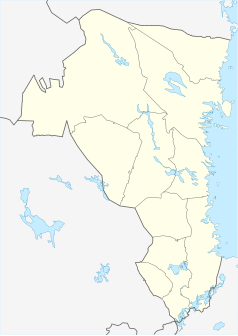Storvik
 Dworzec kolejowy w Storvik | |
| Państwo | |
|---|---|
| Region | |
| Gmina | Sandviken |
| Powierzchnia | 2,67[1] km² |
| Populacja (2018) • liczba ludności • gęstość | 2232[1] 837[1] os./km² |
| Nr kierunkowy | (+46) 290 |
| Kod pocztowy | 812 xx |
| Strona internetowa | |
| Portal | |
Storvik – miejscowość (tätort) w Szwecji, w regionie administracyjnym (län) Gävleborg (gmina Sandviken).
Storvik położone jest w prowincji historycznej (landskap) Gästrikland, nad jeziorem Näsbysjön, ok. 15 km na zachód od Sandviken, przy trasie europejskiej E16. Miejscowość jest ważnym węzłem kolejowym. Krzyżują się tam linie Gävle/Storvik – Ånge (Norra stambanan), Gävle – Falun – Kil (Bergslagsbanan) oraz linia z Mjölby (Godsstråket genom Bergslagen)[2].
Miejscowość rozwinęła się jako osada kolejowa. Pierwsze połączenie kolejowe (linia Gefle-Dala järnväg) oddano do użytku w 1859 r. W 1875 r. otwarto południowy odcinek Norra stambanan[3]. W okresie 1916-1923 Storvik miało status municipalsamhälle w ramach gminy wiejskiej Ovansjö (Ovansjö landskommun). W 1924 r. Storvik zostało przekształcone w köping. W wyniku reformy administracyjnej 1 stycznia 1971 r. Storviks köping zostało rozwiązane, a miejscowość włączona do gminy Sandviken.
W 2010 r. Storvik liczyło 2165 mieszkańców[4].
Przypisy
- ↑ a b c Statistiska tätorter 2018; befolkning, landareal, befolkningstäthet (szw.). Statistikmyndigheten SCB, 2020-03-20. [dostęp 2020-09-08]. [zarchiwizowane z tego adresu (2020-03-24)].
- ↑ Järnväg.net: Frövi-Ställdalen-Borlänge-Storvik-Gävle. Bergslagsbanan (szw.). [dostęp 2014-07-22].
- ↑ Sandvikens kommun: Historia. Järnvägsknuten (szw.). [dostęp 2014-07-22].
- ↑ Statistiska centralbyrån: Tätorter; arealer, befolkning. Tätorter 2010 (szw.). [dostęp 2014-07-22].
Media użyte na tej stronie
(c) Lokal_Profil, CC BY-SA 2.5
This coat of arms was drawn based on its blazon which – being a written description – is free from copyright. Any illustration conforming with the blazon of the arms is considered to be heraldically correct. Thus several different artistic interpretations of the same coat of arms can exist. The design officially used by the armiger is likely protected by copyright, in which case it cannot be used here.
Individual representations of a coat of arms, drawn from a blazon, may have a copyright belonging to the artist, but are not necessarily derivative works.
Autor: Erik Frohne, Licencja: CC BY 3.0
Location map of Gävleborg County in Sweden
Equirectangular projection, N/S stretching 208 %. Geographic limits of the map:
- N: 62.40° N
- S: 60.10° N
- W: 14.20° E
- E: 17.60° E






